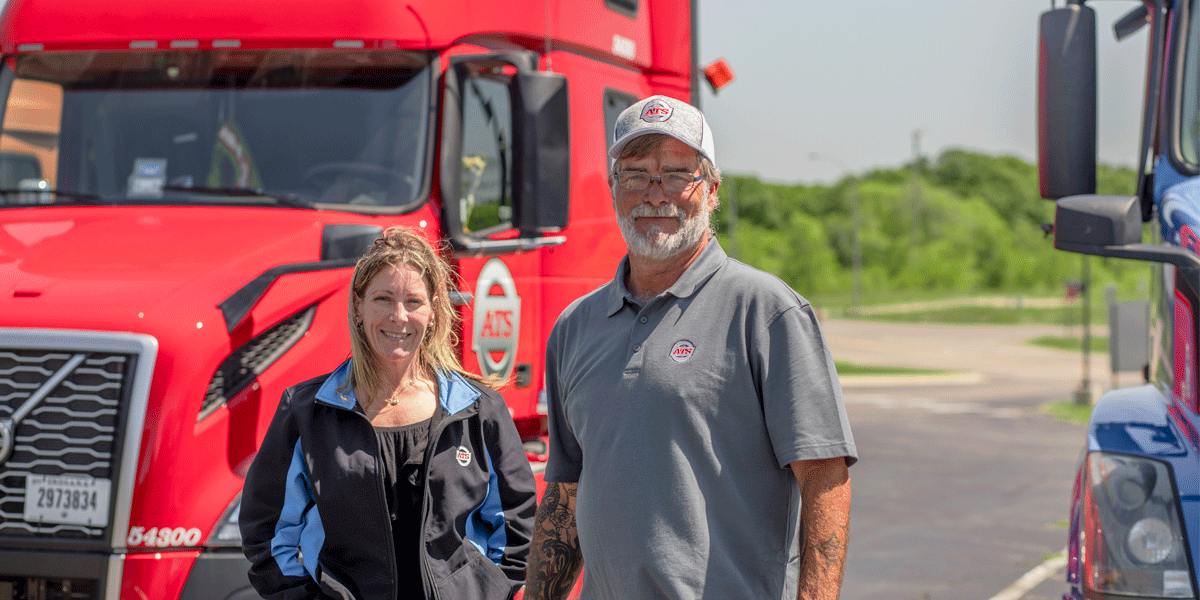Samantha has been working at ATS since 2013, where she began in operations support in the specialized division. She quickly transitioned into a specialized driver manager role and began managing her own fleet of drivers. Samantha currently acts as an operations manager in the van division.
One of the major issues of contention we hear from drivers that come to Anderson Trucking Service (ATS) is that their driver manager wasn’t on their side at their last company.
If you can’t get along with your driver manager, how can you be expected to succeed on the road?
We hear you. And here at ATS, we’ve made it our mission to create a better experience for our drivers. ATS can’t succeed unless we succeed together. That’s why we’ve put thorough, ongoing training practices into place.
I’ve been with the company for nearly a decade, and as an operations manager, I not only oversee the development of my team of driver managers, but I also participate in the training myself.
In this article, I’ll explain to you the different pieces of training our driver managers go through, including
Once you’re done reading, you’ll understand how our team is equipped to help you and ensure you find success out on the road. You’ll also understand how you can use the driver manager relationship to your advantage on the road.
I’ll start by explaining the training new driver managers go through and finish off with the ongoing training they receive.
Onboarding Training
Driver manager training starts the moment new driver managers walk in the door. New driver managers aren’t thrown into the thick of it with a fleet of drivers right when they start. Rather, they go through a five-week onboarding program to get them prepared to handle a team of drivers.
During these five weeks, driver managers have a mentor they sit with for the entirety of their onboarding. They receive a large binder of information that teaches them the basics about the company, policies, and their daily job duties.
They’ll not only have a chance to absorb information from their mentor, but they’ll also sit in driver orientation. They hear what the drivers hear, they have the opportunity to understand what drivers are struggling with, and they can ask questions themselves.
Attending orientation puts them in the driver’s shoes. They attend the classes side-by-side with drivers like you so they not only understand the information but also know what you’re going through. It’s a lot of information to absorb in one week of orientation, so this helps driver managers understand how easy it can be for a driver to forget information that was shared with them in orientation.
Driver managers also attend securement training during their five-week onboarding period. Load securement isn’t an easy process by any stretch of the word. It’s hard work, it’s time-consuming and it can be difficult. Drivers in the flatbed and specialized world haul different types of freight every day — freight they may or may not have hauled before. It can be both tricky and intimidating to secure freight you’re not familiar with.
Drivers should be able to receive guidance from their driver managers when they have questions about what they’re securing. Our driver managers may not be able to provide the final say on how you secure your load — the safety team can do that — but they can get you the answers you need.
The driver managers will also get a feel for what it’s like to lift and throw chains, straps, and tarps. It’s widely understood this isn’t an easy part of your job. When you have questions or you’re frustrated, you deserve to talk to someone who understands what you’re struggling with.
We may be sitting at our desks all day while you’re doing the hands-on, physical labor. But, at the very least, we want to have a taste of what you’re going through so you can receive the adequate support you deserve.

Three-Part Training Series
Driver managers at ATS go through a three-part training series. Each part focuses on a different, yet equally important, aspect of the driver manager position. The trainings focus on:
- Leadership and relationship-building
- Driver coaching and management
- Interoffice collaboration
The first training focuses on leadership. Driver managers learn about relationships and trust. It teaches driver managers how to build a relationship with drivers. Trust is the key to a strong relationship, so it’s an important theme throughout the training. They learn how to build trust and how to get it back if they lose it.
During the training, they’ll learn about their personality and how they like to work. They learn how everyone has a different personality and working style and how they need to take that into account when working with drivers so they can shift their work style to accommodate drivers. It helps driver managers understand their drivers better.
The second training focuses on management and coaching. Driver managers learn how to help their drivers succeed — whether they’re working with company drivers or contractors.
The third training is all about collaboration. It focuses on interoffice, behind-the-scenes relationships, and how driver managers can work with different departments to help their drivers.
The first of the three trainings begins once a driver manager has been with the company for at least six months. Each of the offsite trainings lasts a couple of days. Each part of the training is followed up by a reinforcement program to ensure the techniques are being used.
The reinforcement meetings occur every three weeks and there are nine activities. A group of driver managers meet together and cover important training topics or common driver problems. They work together to resolve roadblocks a driver may experience and how driver managers can help handle the situation.
Since starting the program in the last few years, we’ve seen improvements in the relationships between drivers and their driver managers.
Behind-the-Wheel Training
Most recently, ATS has added behind-the-wheel training. Driver managers get in a truck with the safety team in a private, locked yard.
They drive the truck around a short obstacle course to get a better feel for turns, braking, and more. They also have to execute a backing maneuver.
We all understand trucking is difficult — for a variety of reasons — but this gives driver managers an extra layer of understanding and empathy for what you do day after day.
Ongoing Training
In addition to the three-part training series and behind-the-wheel, driver managers partake in ongoing training.
All driver managers and operations managers at ATS attend weekly safety meetings. Each week, a member of the safety team hosts a meeting on a safety topic. The team may discuss common driving behaviors, as well as general safety topics like distracted driving, following distance, speeding, trailer types, securement, and more.
These ongoing meetings act as great refreshers for driver managers who may need to brush up on some information. It also opens the discussion to the entire team and promotes productive brainstorming sessions.
Additionally, we have call evaluations. Each month, driver managers meet with their operations manager to review several calls. They discuss what they did well on the calls and what they can improve on. This practice is used as a reinforcement tool for driver manager leadership training.
The goal of the call recording is not to spy on drivers; the goal is to ensure driver managers are applying what they learned in training and giving drivers the best experience possible.
ATS utilizes front-facing Lytx camera systems in all our trucks; they’re also utilized by owner-operators who’ve signed on with ATS. A group of driver managers, operations managers, and safety team members meet approximately once per month to talk about Lytx. We get feedback on how the system is working for the drivers, how we can improve the functionality, and how we can help reinforce safe driving behaviors.
How to Make the Most of Your Driver Manager Relationship
While our driver managers do their best to ensure they’re building a strong relationship with you and giving you the support you need, it’s a give-and-take relationship.
As a driver, ensure that you’re communicating your needs and expectations — always. Communication is key. This is especially important when it comes to job expectations, home time needs, problems on the road, and more.
If they don’t know something is wrong or there’s tension somewhere, they won’t be able to help. Let us know when you’re upset so we can improve things and get on the same page.
In addition to talking about issues you’re experiencing, talk about what’s going well. That way, we can adjust accordingly or make note of the positive things. Everyone likes to hear good feedback!
It’s also a good idea to keep an open mind. We all have bad days and we all have to work to be understanding with each other.
It can also help if you develop a relationship with your driver manager and get to know each other. Knowing a little about who’s on the other end of the line always helps and makes the relationship more enjoyable.

Make ATS Your Home — Apply Now
Here at ATS, countless drivers have come to us and told us about their negative past experiences with driver managers. We work to build strong relationships so they can trust someone is looking out for their best interests.
You won’t have to run in bad weather — you make the call when it’s time to pull over. It’s better to have a load arrive late than have you end up in an unsafe situation.
Your home time requests deserve to be respected; we do our best to ensure they’re always met. Family time is important.
For more tips, check out this article one of our driver managers wrote about how to effectively communicate with your driver manager. She’s been with us for two decades.
Curious about ATS after learning more about our driver managers? We’re currently looking for over-the-road drivers in both the dry vans and flatbed divisions. You can fill out an application here or be matched with the perfect opportunity by taking our job matcher quiz.

